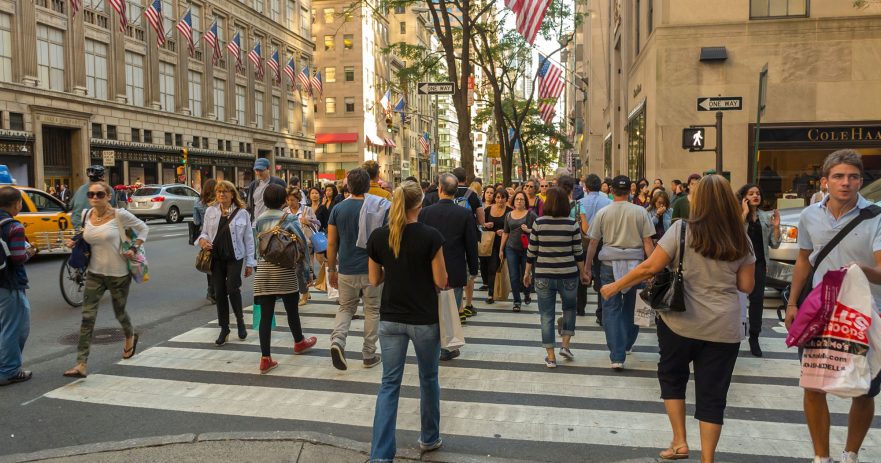This article was originally featured on the RDC blog here.
Designing a successful dispensary can be challenging in any location, but when the retailer is located in a high-crime area this task becomes even more difficult. Since it is not always possible to obtain property in a low-crime area due to competitive markets, zoning laws, and other factors, dispensary owners must mitigate the additional risks associated with high-crime areas through smart facility design and effective security strategies. When combined with proper security measures, dispensaries can be designed to not only deter crime at the retailer, but within the entire area.
Depending on the area, it can be tough to ensure the store is well-protected while still remaining inviting to customers. Potential customers may be hesitant to shop at a cannabis dispensary designed like a prison with high walls and armed security guards, even if these security measures were implemented with the best of intentions.
Instead, cannabis dispensaries can be designed in ways that implement proactive security measures while still remaining welcoming to customers. Even in a high-crime area, it is possible to design an attractive and inviting retailer, facilitate a positive customer experience, and secure valuable assets and property.
Additionally, a recent report from the CATO Institute has shown that cannabis legalization does not appear to significantly impact crime rates. Although cannabis dispensaries can still become targets of crime if they are designed and secured improperly, some data suggests that they actually reduce crime rates in their surrounding area when they are designed with sufficient security.
How Do Dispensaries Impact Crime?
As the US cannabis industry continues to mature, more studies are investigating the relationship between dispensaries and crime. Though research has produced mixed results, many reports have indicated either a reduction in crime rates in areas near cannabis dispensaries or no change at all.
Most research into the impact of cannabis on crime has been performed in medical marijuana markets since they typically pre-date the legalization of adult-use cannabis. One such study concluded that crimes, including robberies, murders and aggravated assaults are reduced by around 13 percent in areas close to states with legal medical marijuana.
Other data out of Sacramento, California suggests “that the density of medical marijuana dispensaries may not be associated with crime rates or that other factors, such as measures dispensaries take to reduce crime (i.e., doormen, video cameras), may increase guardianship such that it deters possible motivated offenders.”
“Cannabis dispensaries have round-the-clock security and monitoring on the property, and in turn, this makes the community safer as a whole,” said Virginia Maggiore, Principal of RDC.
There is less data when it comes to areas with recreational cannabis dispensaries since the industry is younger, but most research indicates that adult-use cannabis has no impact on crime, such as that conducted by RAND Corporation in California which found “no relationship between county laws that legally permit dispensaries and reported violent crime.”
Though the results from research into the relationship between cannabis and crime has produced varying results, cannabis dispensaries can still become targets for crime just like any other business type if they are poorly designed and secured.
Designing a Cannabis Dispensary That Deters Crime
When building-out and operating in a high-crime area, it is important that the cannabis dispensary is designed to address the additional security risks. Cannabis dispensary owners must ensure that the design of their store does not attract crime or open the retailer up to any vulnerabilities. If the cannabis dispensary is improperly designed, weak points in the retailer’s security could act as a beacon to potential criminals looking for an easy score.
One of the main considerations when designing cannabis dispensaries in high-crime areas is ensuring proper surveillance of the premises through the utilization of professionally installed and monitored video surveillance and alarm systems. Another valuable security measure is an exterior lighting system that covers all areas on the premises and the parking lot. When people know that a property is well-lit and properly surveilled, they are less likely to commit a crime.
Another key factor when designing a secure cannabis dispensary is to ensure that the retailer gains a positive reputation in the community by maintaining the premises and removing graffiti and loiterers from the property. Potential criminals are more likely to choose an easier target if they see that the dispensary’s premises is maintained and that small infractions are not tolerated.
“It is important for cannabis businesses to stay on top of maintaining their properties by clearing trash and debris, repairing broken windows, and removing graffiti,” said Virginia Maggiore. “This will send a clear message that the property is being monitored and taken care of.”
Controlling access to the premises is another crucial factor to preventing crime and dispensary design should utilize the architectural elements of the retailer to control ingress and egress, including physical barriers like high-security doors equipped with access control devices and landscaping or bollards in front of exterior access points.
Using concentric circles of protection in the dispensary design is another successful strategy for retailers in high-crime areas. This approach involves increasing levels of security as the design of the facility moves inward through the building toward high-value assets. An example of this is separating cannabis storage areas from areas with customer access by using the walls, high-security doors, and access control systems to create multiple barriers. Dispensaries that are designed with these concentric circles of protection provide better security for cash and cannabis on-site by requiring an intruder to penetrate multiple layers of security.
Finally, the most vital step to ensuring a dispensary in a high-crime area is designed efficiently and securely is to work with professionals with experience in the cannabis industry. Cannabis dispensaries designed without consulting experts may not meet regulatory requirements and even “legally compliant” retailers may have gaps in security that increase the dispensary’s risk of crime.
How Can RDC Help?
Utilizing an architecture and design firm and security consultancy to design and build-out the cannabis dispensary is the only way to ensure quality, compliant, and secure designs. RDC’s team of expert architects and designers have worked extensively with cannabis dispensaries to build-out successful and compliant stores and we are prepared to help design dispensaries in any area!
How Can Sapphire Risk Help?
When choosing creating quick and compliant cannabis business floor plans, you should consult with professional security experts. Tony Gallo and the team at Sapphire Risk Advisory Group have experience working with architects and designers like RDC to ensure cannabis businesses are designed compliantly and efficiently. Follow us on social media to stay up to date with the latest cannabis security strategies!
- 3D Dispensary Security Tour
- Natural Medicine Security Plan for Colorado Psilocybin Application

- New Jersey: Cannabis Consumption Area Application

- Cannabis in the US Virgin Islands

- Case Study: New Jersey Cannabis Retailer

- Delivery Vehicle Security

- Crime Prevention Through Environmental Design (CPTED)

- Schedule III: Cannabis Regulatory Disruptions Ahead

- Perfect Your Delaware Cannabis Business License Application With a Security Consultant

- Our Story: Sapphire Risk Advisory Group

